My timing couldn’t have been much worse. When I checked in for my flight from Chiang Mai to Bangkok at 8:30 PM on Tuesday night, trouble was just beginning to brew. When I boarded the plane and took off, word had just made it to my friends in Thailand that the Suvarnabhumi (Soo-Va-boom) International Airport was being besieged by anti-Prime Minister Somchai Wongsawat protesters. By the time I had landed at 10:30 PM, the outer entry area to the main concourse was full of yellow-shirted people chanting, and the inside was filled with reporters walking from group to group of people waiting with their luggage.
I was preoccupied with retrieving my luggage from storage and repacking and making arrangements to check in at 3 AM for my 6 AM flight. It was going to be a long night in the concourse for me either way, so I wasn’t paying that much attention. My mobile phone number had been deactivated, so there was no way for my friends to get ahold of me. There were a lot of protesters both outside and milling about inside, but the demonstration was peaceful and I knew the People’s Alliance for Democracy (PAD) had been protesting for weeks so it didn’t really bother me. It was late, people were still getting through the lines to arrive for check-in, so I figured it was just an inconvenience.
I had no idea the PAD had broken through security lines and were now announcing that only airlines that had express permission from them would be allowed to land. I spent a couple hours drinking an over-priced mocha at the Starbucks downstairs, the only restaurant still open, and came up at 3 AM to see some airport employees posting a sign that NWA flight 22 to Tokyo had been delayed from 6 AM to 10:30 PM Wednesday. The waiting passengers were shocked – and confused. At that point there was no information beyond that to share. We had no idea if it was an isolated incident due to NWA difficulties or something to do with the protest.
Over the next couple of hours more information dribbled out. Finally NWA opened their check-in counter to receive passengers and inform them that, at best, the new check-in time would be 7 PM that night. They gave us phone numbers to call to get status updates. No hotel accommodation was being provided by the airline – we were on our own until 7 PM that night. Maybe.
I was left with a dilemma and a decision. My inactive mobile phone was a big problem, as was my severe lack of cash. I had withdrawn my daily limit in cash to pay for my luggage storage. My inactive SIM card meant I had no way of contacting my Thailand friends in hopes of getting better news updates. I had USD and Euros, but none of the exchange places in the airport were open, and nobody could say if any of the businesses in the airport would actually open that day. Information was at an extreme minimum - not even a single announcement was being made over the airport intercom.
Finally I decided to get rid of my excessive luggage. I checked it back into storage and quickly repacked my carry-on with the few items I thought I might need for the day and maybe a night. I figured the cost of storing my bags for an extra 12 hours was more than worth the freedom of at least being able to get around the airport more easily.
I walked down to the lower level, intending to scout the situation. Already it seemed the number of airport taxis were limited. I finally decided to just make a break for the downtown where I could hopefully exchange some money and get a new SIM card for my phone and maybe find an coffee shop or internet café to sleep in for the day (note, by now I was going on 24+ hours with no sleep). I had just enough cash left to pay for the Airport Express shuttle to Sukhumvit, buy a Skytrain ticket to a part of town I knew fairly well, and purchase a SIM card and phone credit. Then I had to wait until 9 am to get more cash.
Then, flush with money again, I found food, but no internet. I called my Chiang Mai friends who passed on the news that the old Don Nueang Airport had been reopened. I got through to the airline, which told me the flight has officially been cancelled for that day and the following day. Regardless of what happened now I was going to miss Thanksgiving in the US. It would have been my first Thanksgiving home in 6 years, and I know many of the passengers on my flight and others that were being cancelled were those trying to get to the US for the holiday.
I told the airline representative that I thought I might try to go back to Chiang Mai. She agreed that this was a good idea, so I hung up and headed off for the old airport to see if there was any chance of getting a seat on a flight.
Not surprisingly, the few local flights were booked solid. However, the train station was just across the street from the old airport, so I walked over there and found, to my great satisfaction, that there was a second-class seat available on an overnight train leaving at 3 PM. I happily paid my 383 Baht (about 11 USD), and set off to find a local internet café to update people about my situation and plans.
It was a great relief to finally board the train in the afternoon. I was extremely grateful that in packing my carryon I had left in two warm sweaters and my Madagascar silk wrap and another neck scarf. I was still wearing my traveling clothes – jeans, boots, a couple of layers on top. The 2nd class car was only standard padded reclining seats, fans for air circulation (good thing it was the cool season and there was no need for air conditioning), and wide-open windows. It was actually a very pleasant time of year to be traveling with open windows, and I wish I could’ve been more attentive to the passing countryside in daylight. But after 36 hours with no sleep, I was pretty much done for. My one irritation is that they turned on and left on florescent lights all night long in the cars – no chance for good darkness for sleep. It was a 14-hour journey in all, and we pulled in to the Chiang Mai station at a very cool 5:30 AM Thursday. I took a tuk-tuk from the station and by 6 was right back where I started at Fi’s house.
She came down and let me in with that magnanimity of a hostess receiving a relative for Thanksgiving – and then banished me to a much-needed shower while she tried to capture another hour’s rest. I am now spending the morning catching up on the latest news about the situation and then planning on relaxing this evening with friends for a nice Thanksgiving dinner locally. At least I will get to personally enjoy the pies that I made before I left, thinking to be eating my mother’s, aunt’s and grandmother’s pies in the States. From the looks of it, things are still very much up in the air, so for the time being I will continue to be a Suvarnabhumi refugee.
Thanks to those of you that expressed concern over my whereabouts. As you can see from above, I was safe the entire time, and probably would've been equally safe had I chosen to stay in Bangkok. However, I am with friends in Chiang Mai, so I am more comfortable being here rather than in a random hotel. This probably will resolve itself in a couple of days and I will be able to resume my plans for re-entry into the US. However, if it does drag on, at least I am away from the center of the action and in a place where I have access to information. I will continue updating this as needed over the coming days!























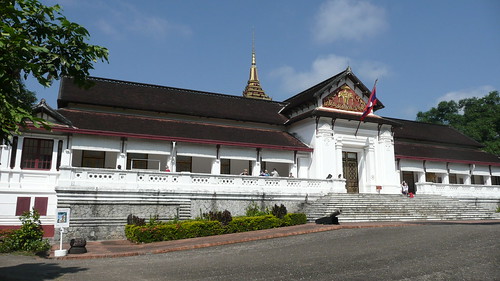 As the name suggests, it was originally built as a northern palace for the royal family (early 20th century) and has since been turned into a museum displaying the family's life style and ancient relics from the area.
As the name suggests, it was originally built as a northern palace for the royal family (early 20th century) and has since been turned into a museum displaying the family's life style and ancient relics from the area.
 You can see the golden stupa in the photographs above at the top of the hill behind.
One of the other rules that is strictly enforced in Laos - and which really amuses me, is the "no shoes" rule. It's generally polite anywhere in Asia to remove your shoes before entering a house, but here they even ask you to take off your shoes before entering a hotel, store or in these museums. A lot of disgruntled tourists - but as I happen to love running around barefoot, so it was great for me!
You can see the golden stupa in the photographs above at the top of the hill behind.
One of the other rules that is strictly enforced in Laos - and which really amuses me, is the "no shoes" rule. It's generally polite anywhere in Asia to remove your shoes before entering a house, but here they even ask you to take off your shoes before entering a hotel, store or in these museums. A lot of disgruntled tourists - but as I happen to love running around barefoot, so it was great for me!
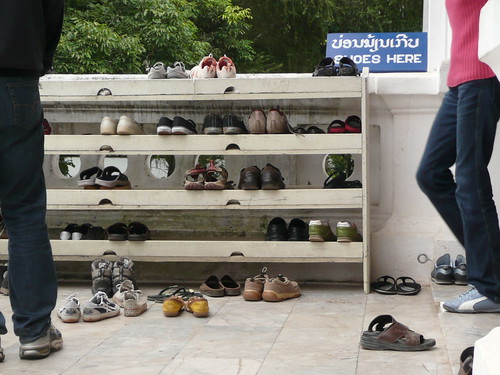 The grounds included a closed theatre, but I had fun photographing the reflections in the doors:
The grounds included a closed theatre, but I had fun photographing the reflections in the doors:
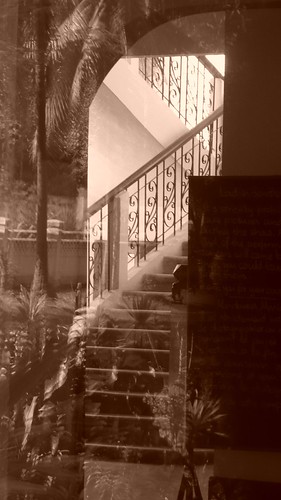 And the detritus of oil lanterns apparently used in some of the performances left outside:
And the detritus of oil lanterns apparently used in some of the performances left outside:
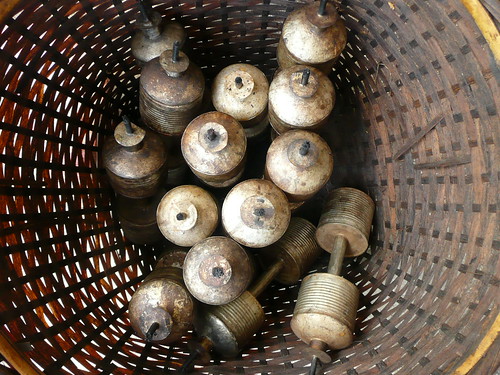 And you just have to love a place that can even make rubbish bins look good:
And you just have to love a place that can even make rubbish bins look good:
 The temples are the main reason for Luang Prabang's existence.
The temples are the main reason for Luang Prabang's existence.
 Even the bustling tourist trade and the night market revolve around the life of temples and the Buddhist traditions, festivals and celebrations.
Even the bustling tourist trade and the night market revolve around the life of temples and the Buddhist traditions, festivals and celebrations.
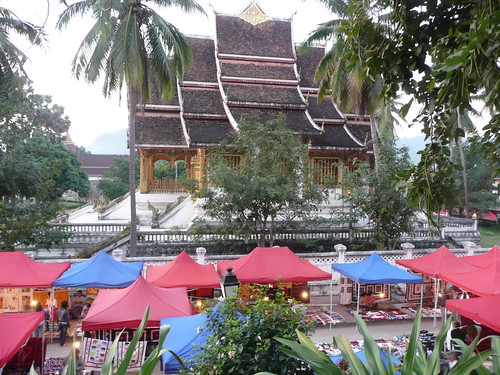 Long a center of pilgrimage and retreat, the numerous Buddhist temples serve as a training ground for novice monks. It is expected that all devout Buddhist men serve as monks at some point in their lives, and many do. LP is one of the major cities for young boys (ages 15-20) to go and study as novice monks for a period of three or so months. So one of the major sights in LP is the young boys wrapped in shockingly bright orange robes running from temple to temple.
Long a center of pilgrimage and retreat, the numerous Buddhist temples serve as a training ground for novice monks. It is expected that all devout Buddhist men serve as monks at some point in their lives, and many do. LP is one of the major cities for young boys (ages 15-20) to go and study as novice monks for a period of three or so months. So one of the major sights in LP is the young boys wrapped in shockingly bright orange robes running from temple to temple.
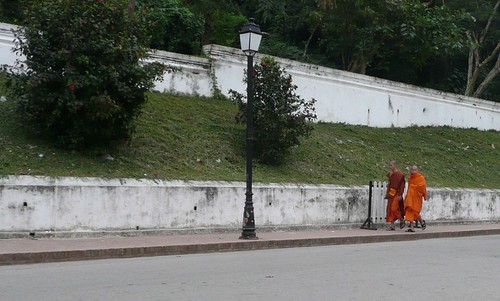 Obligatory young monk picture.
One of the major attractions is the early morning distribution of rice to the young monks by towns people. Every day around six am a family member will emerge with a warmer of sticky rice and a few morsels of food and sit on the road outside the house. A column of young novices will suddenly appear, each carrying a brass begging pot. They will pause, one by one in front of each person offering food and that person will put a small handful of sticky rice into each brass begging pot. The last novice in the column usually brings a small gift of thanks or blessing for those giving offerings.
Monks are only allowed to beg in the morning, and must take only what is given to them and nothing more. What appears in their pot is their single meal for the day.
I did not take any pictures of this - I just didn't feel right in anyway, shape or form. Nonetheless, it is a nice tradition to see, and I think it is a good character building activity for young, growing men. It teaches discipline, self-awareness and communal inter-dependency. Women can do it also, but it is a different and (apparently) less public experience.
So the snap color of washed ropes airing on a line and the sounds of monks chanting in the mornings and evenings and the lively chatter of the young men dashing between temples creates an atmosphere of contemplation, reflection and anticipation of personal growth that saturates the entire city.
Obligatory young monk picture.
One of the major attractions is the early morning distribution of rice to the young monks by towns people. Every day around six am a family member will emerge with a warmer of sticky rice and a few morsels of food and sit on the road outside the house. A column of young novices will suddenly appear, each carrying a brass begging pot. They will pause, one by one in front of each person offering food and that person will put a small handful of sticky rice into each brass begging pot. The last novice in the column usually brings a small gift of thanks or blessing for those giving offerings.
Monks are only allowed to beg in the morning, and must take only what is given to them and nothing more. What appears in their pot is their single meal for the day.
I did not take any pictures of this - I just didn't feel right in anyway, shape or form. Nonetheless, it is a nice tradition to see, and I think it is a good character building activity for young, growing men. It teaches discipline, self-awareness and communal inter-dependency. Women can do it also, but it is a different and (apparently) less public experience.
So the snap color of washed ropes airing on a line and the sounds of monks chanting in the mornings and evenings and the lively chatter of the young men dashing between temples creates an atmosphere of contemplation, reflection and anticipation of personal growth that saturates the entire city.


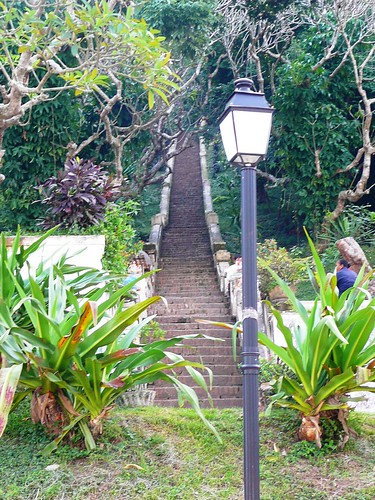 Like any self-respecting holy city, Luang Prabang not only brags of too many Buddhist temples and stupas, but also of a big hill in the center of town with a big stupa right at the top. And a lot of stairs to climb to get there.
Like any self-respecting holy city, Luang Prabang not only brags of too many Buddhist temples and stupas, but also of a big hill in the center of town with a big stupa right at the top. And a lot of stairs to climb to get there.
 (The ones I've already climbed)
(The ones I've already climbed)
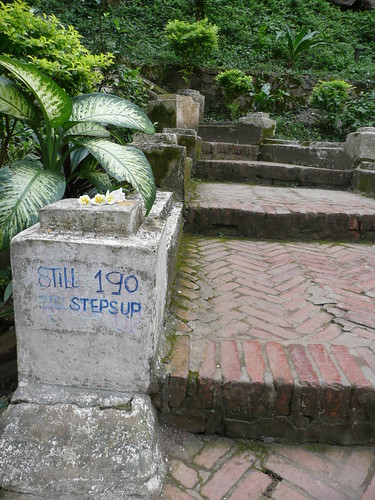 Excellent
I paused to admire the golden stupa, which apparently is a fairly new construction at the top of the hill, but replaces several centuries of past monuments.
Excellent
I paused to admire the golden stupa, which apparently is a fairly new construction at the top of the hill, but replaces several centuries of past monuments.
 More interesting were the types of offerings people left - the marigold cone with incense is particularly popular in Luang Prabang.
Then I wandered down and around yet a few more stairs:
More interesting were the types of offerings people left - the marigold cone with incense is particularly popular in Luang Prabang.
Then I wandered down and around yet a few more stairs:
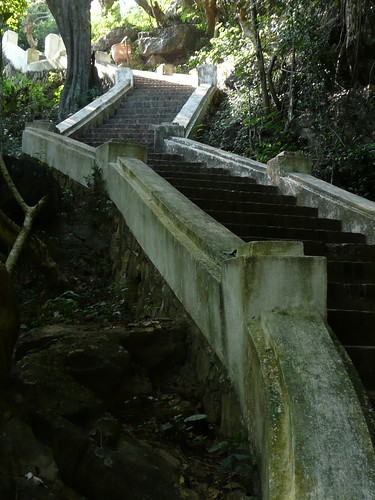 Peeked in a few windows:
Peeked in a few windows:
 And climbed a few more stairs:
And climbed a few more stairs:
 Until I found it:
Until I found it:
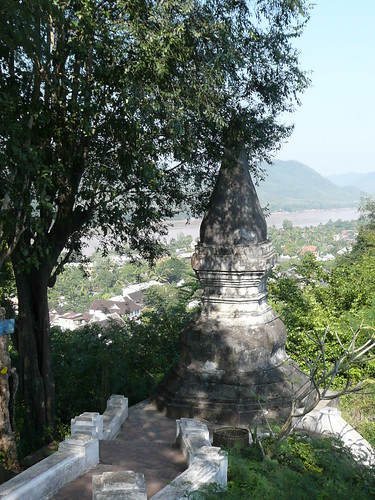
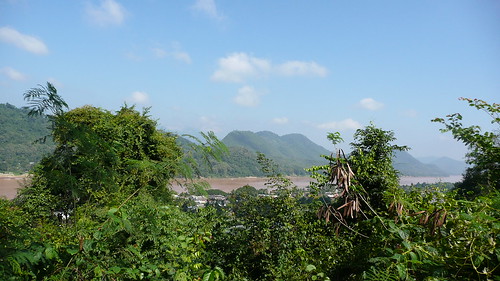 I sat on the far side of this little stone stupa and, for the next day and a half, this view was my company.
I sat on the far side of this little stone stupa and, for the next day and a half, this view was my company.
























